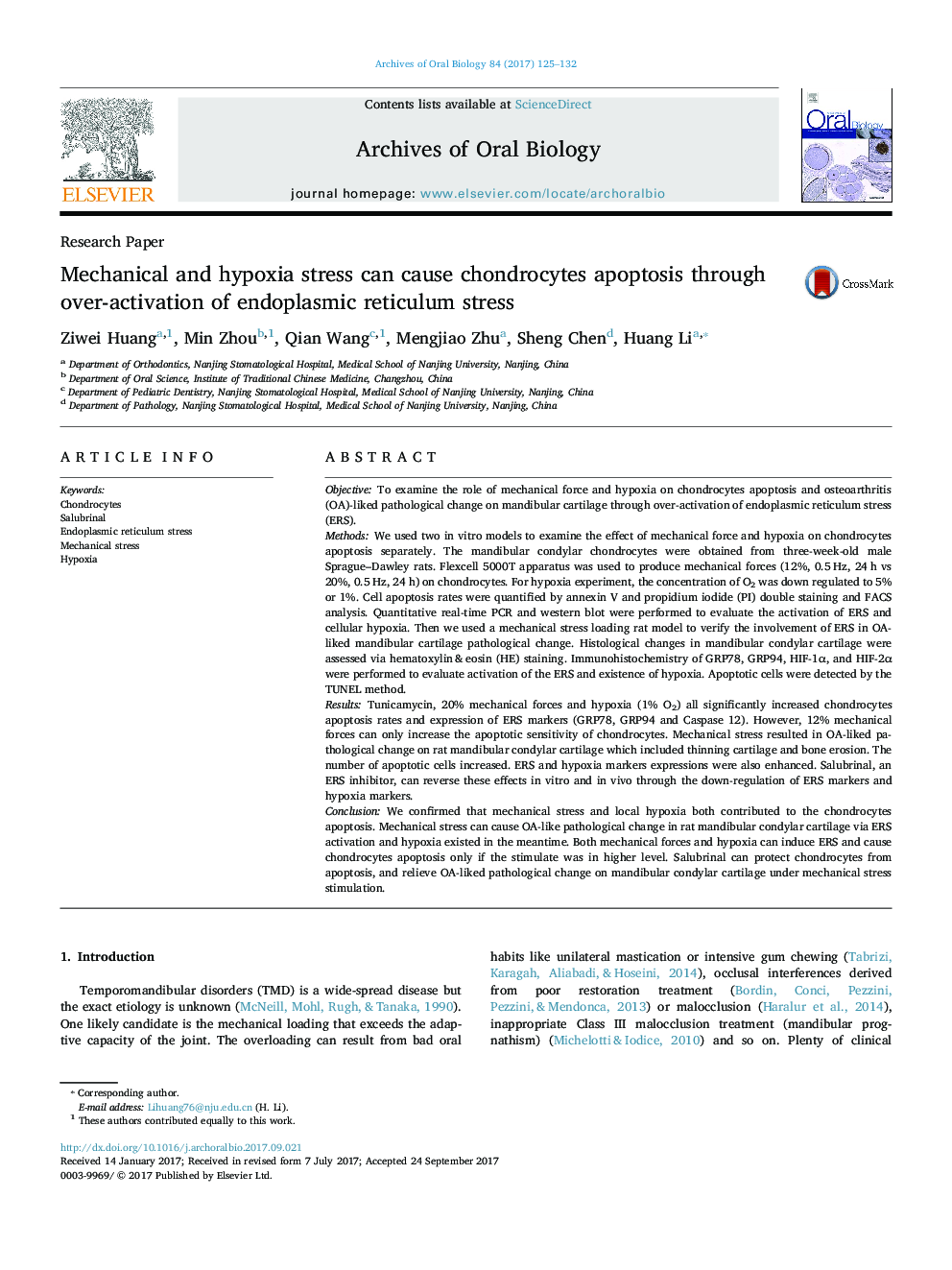| کد مقاله | کد نشریه | سال انتشار | مقاله انگلیسی | نسخه تمام متن |
|---|---|---|---|---|
| 5637943 | 1583269 | 2017 | 8 صفحه PDF | دانلود رایگان |
- Mechanical stress and local hypoxia both contributed to the chondrocytes apoptosis.
- Mechanical stress can cause OA-like pathological change in rat mandibular condylar cartilage via ERS activation and hypoxia existed in the meantime.
- Both mechanical forces and hypoxia can induce ERS and cause chondrocytes apoptosis only if the stimulate was in higher level.
- Salubrinal protect chondrocytes from apoptosis, and relieve OA-liked pathological change on mandibular condylar cartilage under mechanical stress stimulation.
ObjectiveTo examine the role of mechanical force and hypoxia on chondrocytes apoptosis and osteoarthritis (OA)-liked pathological change on mandibular cartilage through over-activation of endoplasmic reticulum stress (ERS).MethodsWe used two in vitro models to examine the effect of mechanical force and hypoxia on chondrocytes apoptosis separately. The mandibular condylar chondrocytes were obtained from three-week-old male Sprague-Dawley rats. Flexcell 5000T apparatus was used to produce mechanical forces (12%, 0.5 Hz, 24 h vs 20%, 0.5 Hz, 24 h) on chondrocytes. For hypoxia experiment, the concentration of O2 was down regulated to 5% or 1%. Cell apoptosis rates were quantified by annexin V and propidium iodide (PI) double staining and FACS analysis. Quantitative real-time PCR and western blot were performed to evaluate the activation of ERS and cellular hypoxia. Then we used a mechanical stress loading rat model to verify the involvement of ERS in OA-liked mandibular cartilage pathological change. Histological changes in mandibular condylar cartilage were assessed via hematoxylin & eosin (HE) staining. Immunohistochemistry of GRP78, GRP94, HIF-1α, and HIF-2α were performed to evaluate activation of the ERS and existence of hypoxia. Apoptotic cells were detected by the TUNEL method.ResultsTunicamycin, 20% mechanical forces and hypoxia (1% O2) all significantly increased chondrocytes apoptosis rates and expression of ERS markers (GRP78, GRP94 and Caspase 12). However, 12% mechanical forces can only increase the apoptotic sensitivity of chondrocytes. Mechanical stress resulted in OA-liked pathological change on rat mandibular condylar cartilage which included thinning cartilage and bone erosion. The number of apoptotic cells increased. ERS and hypoxia markers expressions were also enhanced. Salubrinal, an ERS inhibitor, can reverse these effects in vitro and in vivo through the down-regulation of ERS markers and hypoxia markers.ConclusionWe confirmed that mechanical stress and local hypoxia both contributed to the chondrocytes apoptosis. Mechanical stress can cause OA-like pathological change in rat mandibular condylar cartilage via ERS activation and hypoxia existed in the meantime. Both mechanical forces and hypoxia can induce ERS and cause chondrocytes apoptosis only if the stimulate was in higher level. Salubrinal can protect chondrocytes from apoptosis, and relieve OA-liked pathological change on mandibular condylar cartilage under mechanical stress stimulation.
Journal: Archives of Oral Biology - Volume 84, December 2017, Pages 125-132
